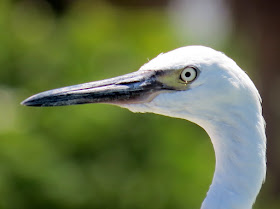Little Blue Heron x Tricolored Heron hybrid, Hammonasset State Park (Connecticut, USA), 23rd July 2013 - copyright Len Blumin
(photo ID: 2917)
Len makes a good case for the hybrid ID of this interesting bird. Initially I was not entirely convinced but thought it was worth putting out there for others to comment on, and to see if other birds like this come out of the woodwork. Turns out it was worth it as more information came to light.
As Len says, this bird's posture and structure resembles that of a Tricolored Heron, and of course much of the plumage does too. Apparently some think the bill is intermediate in structure between Tricolored and Little Blue - a bit too subtle for my eye if so. The obvious anomaly for pure Tricolored in terms of plumage is the grey belly and thighs (better seen on the photos below) - Tricolored should be pure white here. Len has considered if this might be melanism but thinks this is unlikely on feathers that should be pure white. I wasn't so sure about that - certainly there are records of normally white herons that have appeared grey, although at least some of these have been contaminated rather than being genuinely melanistic. Nevertheless, in some cases they had a very even covering of grey and contamination was not obvious, so I was not completely convinced that we could rule that out in this case.
There are a couple of other features that Len points to that support Little Blue Heron involvement. One of those is the iris colour which Len describes as pale yellow, or straw yellow. It's normally brown, red or pink on adult Tricolored Heron. I think a pale yellow iris is ok on immature Tricolored Heron (but Len's bird doesn't show any signs of juvenile plumage) - is it ok in an adult? I don't get to see many Tricolored Herons, being in the UK, so trawled through some images online. On some birds the majority of the iris seems to be yellowish but surrounded by pink or red on the outside of it, while on others even that wasn't very clear, such as
this one. So wasn't quite sure about this - did this really rule out pure Tricolored Heron?
Finally Len also draws attention to the manner in which it was feeding. He writes, "The bird foraged rather deliberately looking for fish, as we often see with the Little Blue, whereas the usual Tricolored foraging is often more active, even frenetic, recalling the fishing technique of the Reddish Egret cousin."
So, I wondered, is there enough to call this a hybrid, or is it more likely a very odd but genetically pure Tricolored Heron? Well, it turns out there were 2-3 birds seen in the area in the autumn of 2011 which superficially resembled first calendary-year Tricolored Herons but with anomalies including excessive
white in the plumage. They continued into the following year and some observers recognised that the white in the plumage might be a result of hybridisation with Little Blue Heron, noting an intermediate bill structure. However it was hard to be sure that the white wasn't down to leucism until the birds were seen again later on in 2012 and in subsequent years. Just as Little Blue Herons of this age would turn from white to grey, the amolous features of these birds (or at least one of them) had turned from including too much white to too much grey. The evidence for them being hybrids with Little Blue Heron had suddenly became a lot stronger. The records have now been accepted on eBird as this hybrid. Thanks to Steve Mlodinow for drawing my attention to this, and you can read about it more on
Nick Bonomo's website and see photos of one of the birds in their second calendar-year.
Little Blue Heron x Tricolored Heron hybrid (same bird as in photo ID
2917 above), Hammonasset State Park (Connecticut, USA), 23rd July 2013 -
copyright Len Blumin
(photo ID: 2918)
Little Blue Heron x Tricolored Heron hybrid (same bird as in photo IDs
2917-2918 above), Hammonasset State Park (Connecticut, USA), 28th July 2013 -
copyright Len Blumin
(photo IDs: 2919-2920)
Little Blue Heron x Tricolored Heron hybrid (same bird as in photo IDs 2917-2920 above), Hammonasset State Park (Connecticut, USA), 31st July 2013 - copyright Len Blumin
(photo ID: 2921)
Little Blue Heron Egretta caerulea
Tricolored Heron Egretta tricolor






















































